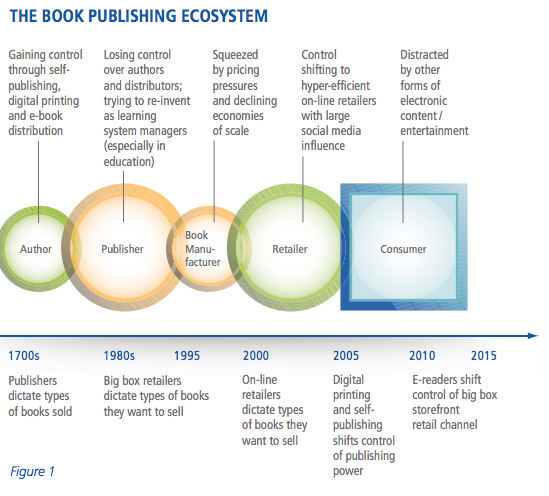December 12, 2013
New study contains silliest publishing infographic ever
by Sal Robinson
Infographics are eminently mockable, but some are more mockable than others. Top of the pile this week is IT Strategies’ infographic illustrating the history of publishing from the 1700s to 2015 (wait, what?) in their new report “The Evolution of the Book Industry: Implications for U.S. Book Manufacturers and Printers” (pdf here). Behold:
This infographic deserves some time and pondering and beating-of-heads-against-walls (optional whether it’s yours or the designer’s).
It could be criticized for simple incoherency. For instance, the text suspended above the circles and squares, like so many low-calorie flavorless lollipop heads, apparently refers to what’s going on now, and not to the dates listed underneath: authors are gaining control through etc etc now, book manufacturers are being squeezed in these days and no other days, consumers are distracted right this very minute. And contrary to what the layout seems to suggest, publishers are not permanently stuck somewhere between the 1980s and 1995.
It could also be criticized for being based on a ludicrously small sample population: for this report, from which broad conclusions would be drawn about over 200 years of an industry’s history, IT Strategies interviewed “4 publishers, 5 book manufacturers, and 10 consumers.” Presumably those consumers were square, blue, and representative of the millions of Americans who bought a book last year.
But best of all might be criticizing it for not being all that accurate. It’s probably unfair to fault an infographic for a lack of subtlety, but the system this image demonstrates is far more Games of Thrones-like than actual publishing has ever been. The verbs are key here—“dictate,” “shifts control.” It’s not that the various players in publishing don’t try their damnedest to dictate something or other, but far, far more often American publishing has operated on the basis of convenience, compromise, and the broadest possible embrace of different types of books and ways to sell them to consumers.
For instance, the year 2000 on the infographic, when “on-line retailers dictate the types of books they want to sell.” Now this here is bullshit: it’s rare that online retailers actually pick and chose between the types of books they will sell (and whenever they do, it induces reader fury and general chaos) — there’s almost no advantage for them and considerable disadvantages. What they do dictate, and what a series of retailers have attempted to dictate, and what publishers themselves also dictate, is the terms on which they are willing to sell them.
Many, many people in this ecosystem do not agree on terms — the history of publishing is the history of debates over terms: how much up front, what percentage of sales, with what discounts or co-op, when is payment due, and so on. These debates involve all of IT Strategies’ lollipops, though they have not always been neatly distinguished: this is, after all, an industry where for a long time book manufacturers were also publishers and retailers (and where, with the rise of e-books, those categories may be partly collapsing again). And in all these negotiations, parties have had the upper hand at different moments not necessarily as a group (viz. the DOJ lawsuit) but based on individual heft, the position taken by governments, and the skillful appropriation of new technologies. It is ridiculous and unfair, for instance, to characterize authors who self-publish as either a brand-new phenomenon, or one that unilaterally shifts the balance of power in publishing, when a few self-published authors do extremely well and many do not.
And it’s similarly nonsensical to say that publishers are losing control of authors and distributors: for one thing, all of us have been playing each other for a long, long time. Furthermore, all members of the ecosystem have habitually allowed other concerns than power, control, and profit to influence their decision-making.
My point is not to unnecessarily pile on a pretty innocuous white paper (which, by the way, reported that “60% of eBooks downloaded in the US are never read”), but just to say that the publishing business, while it often rewards the aggressive and efficient, is not well-served by IT Strategies’ Darwinian shape-scapes. And that anyone who assumes that publishing has a fixed model that some fundamentally pretty disgusting websites have “disrupted” is missing out on a sizeable part of the picture.
Sal Robinson is an editor at Melville House. She's also the co-founder of the Bridge Series, a reading series focused on translation.
